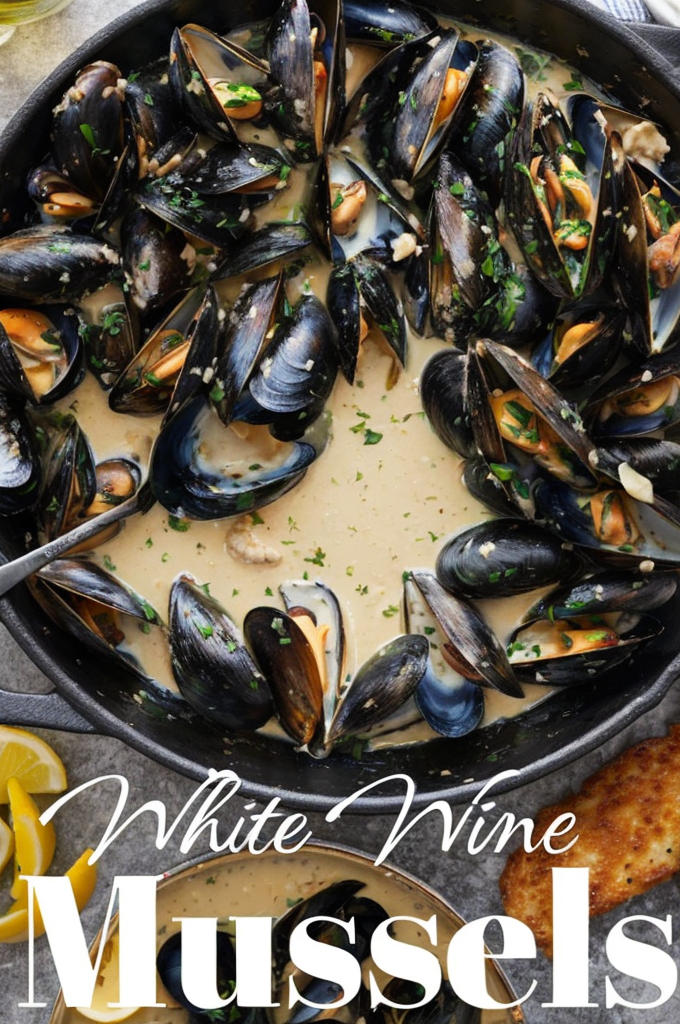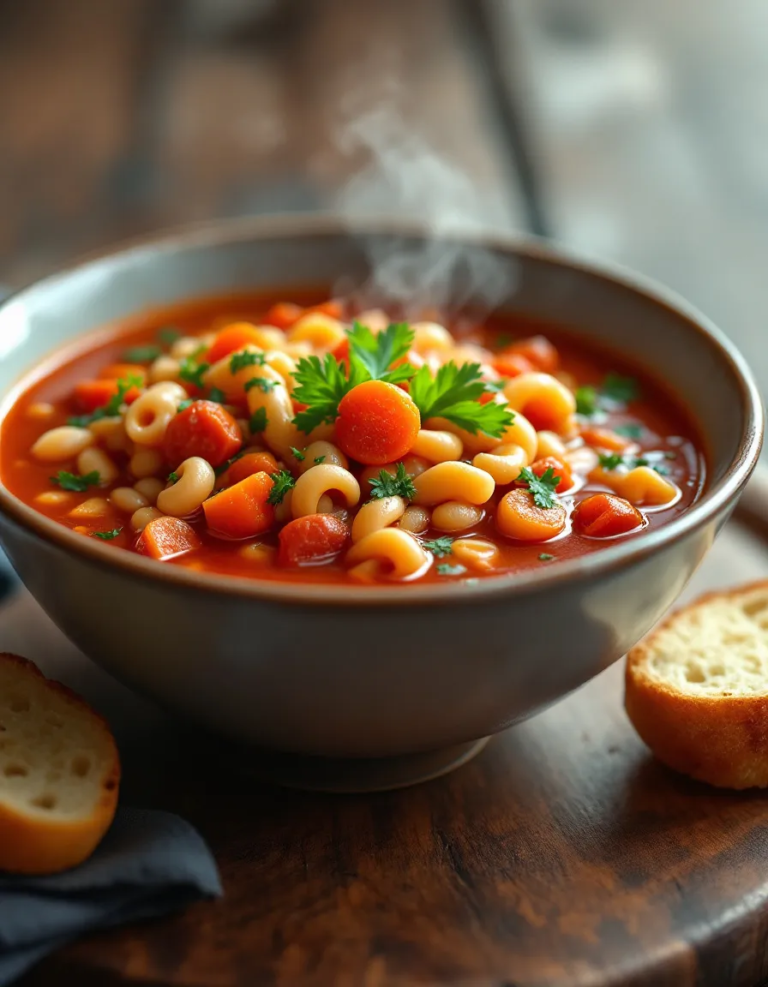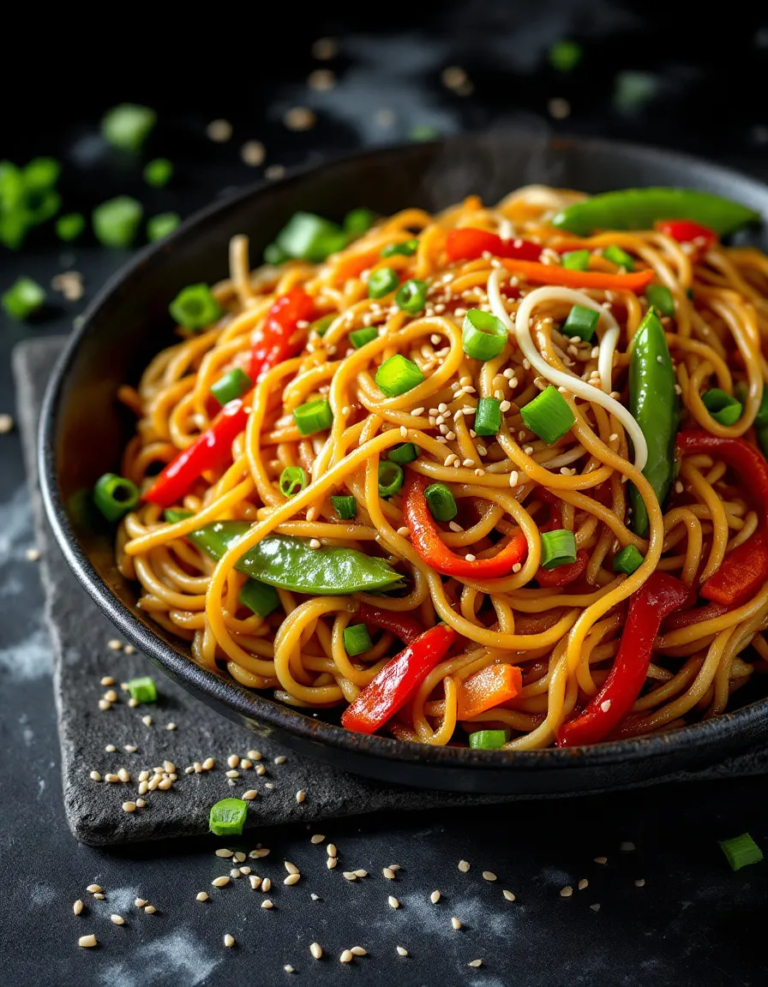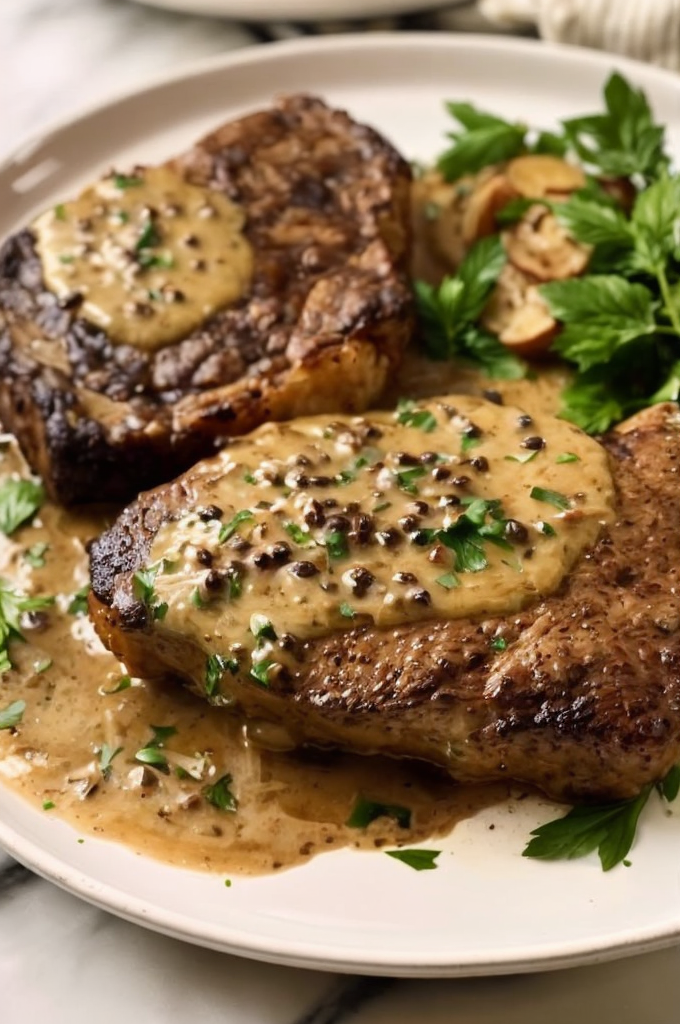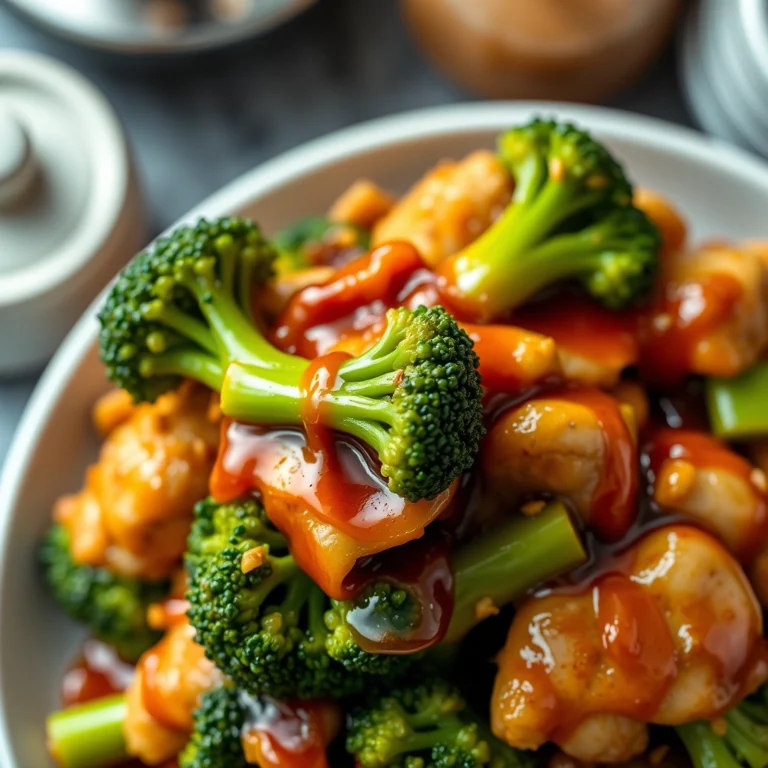Easy Mussels with White Wine Sauce – Ready in 30 Minutes
Easy Mussels with White Wine Sauce – Ready in 30 Minutes: A Gourmet Delight
Enjoy a touch of gourmet dining with our Easy Mussels in White Wine Sauce that can be fully prepared in just 30 minutes. This recipe effortlessly melds the essence of the ocean with rich, aromatic flavors of white wine and fragrant herbs. Perfect for a light dinner or as an impressive appetizer, this mussel dish is both elegant and comforting.
Mussels are the star of this meal, providing a delicate taste of the sea that pairs beautifully with the crisp, acidic delight of white wine. The sauce is expertly balanced with hints of garlic, lemon, and parsley, making each bite an explosion of flavors. Despite its refined taste, this recipe offers amazing convenience and simplicity, making it a great choice for both weeknight meals and special occasions.
Quick Recipe Highlights
- Flavor Profile: Delicate, with a balance of sea brininess and acidic white wine undertones complemented by garlic and lemon.
- Texture: Plump, tender mussels with a smooth, slightly thickened sauce that clings beautifully.
- Aroma: A harmonious blend of oceanic scents intermingled with pungent garlic and fresh citrus notes.
- Visual Appeal: A vibrant array of shiny black shells contrasting with the pale, lemony sauce adorned with specks of fresh green parsley.
- Skill Level Needed: Suitable for beginners; requires basic kitchen skills such as sautéing and steaming.
- Special Equipment: A large pot or deep skillet with a lid is essential for evenly cooking the mussels.
Recipe Overview
- Difficulty Level: This recipe earns its “easy” classification due to its straightforward cooking steps and minimal ingredient list. The process of steaming mussels is particularly simple, requiring attention only to timing.
- Category: Perfect as a main course when paired with crusty bread or as a light starter, this dish suits various meal structures effortlessly.
- Cuisine: Mussels with white wine sauce is rooted in French culinary traditions, highlighting refined flavors and clean presentation typical of classic French cuisine.
- Cost: Mussels are often an affordable seafood choice, making this dish a cost-efficient yet luxurious option. The addition of white wine might slightly elevate the expense, but it remains economical compared to other seafood recipes.
- Season: Best enjoyed in any season, as fresh mussels are available year-round, though they are especially delightful in spring and summer.
- Occasion: This dish is suitable for everything from casual weekday dinners to more celebratory occasions such as dinner parties or holiday gatherings.
Why You’ll Love This Recipe
The taste and texture of these mussels in white wine sauce are truly captivating. The natural sweetness of the mussels, enhanced by the elegant wine-based sauce, creates an immediately satisfying flavor profile. Paired with crusty bread or served over pasta, this dish’s robust sauce clings perfectly to each morsel, delivering a delightful mouthfeel that’s hard to resist.
Convenience is another key reason you’ll favor this recipe. With a total preparation time of just half an hour, it fits seamlessly into busy schedules. The use of just a few fresh ingredients means minimal preparation, with easy-to-follow steps making it a breeze, even for novice cooks.
Nutritionally, mussels are a powerhouse, rich in lean protein, omega-3 fatty acids, and essential minerals like zinc and iodine. This makes the dish not only flavorful but also a healthy addition to your dining repertoire, giving you a delightful way to introduce seafood into your diet.
Socially, this dish is a fantastic centerpiece for gatherings. Whether served as a shared appetizer or a main course, it brings people together, encouraging engaging conversations over a delicious, communal-style feast. Its sophisticated flair adds a touch of elegance to any setting, making it an impressive choice for entertaining guests.
Finally, the recipe’s cost-effectiveness is notable. Mussels tend to be budget-friendly, and the simple ingredient list keeps costs manageable. The white wine, while adding a luxurious touch, need not be expensive, allowing you to create a gourmet experience without breaking the bank.
Historical Background and Cultural Significance
The origin of mussels cooked in white wine sauce can be traced back to the coastal regions of France and Belgium, where seafood has been a staple ingredient for centuries. The dish reflects the culinary traditions of using readily available natural resources, emphasizing simplicity and flavor authenticity.
Culturally, mussels are celebrated as a versatile seafood option, deeply embedded in European cuisine. Whether enjoyed at brasseries in France or in the Belgian classic ‘moules-frites’, mussels have remained a beloved ingredient, cherished for their culinary adaptability and delicious taste.
Over time, the recipe has evolved, with variations introduced in different cultures to adapt to local ingredients and palates. The addition of cream, different herbs, or spices can be seen in versions from other European countries, each offering a unique twist to the classic base of mussels in white wine.
Regional variations abound, from Belgian beer-braised mussels to Italian versions showcasing tomatoes and herbs. These adaptations illustrate the dish’s adaptability, with each region adding its own signature flavors while maintaining the core elements that make mussels in white wine sauce so appealing globally.
Ingredient Deep Dive
White wine, a key ingredient in this recipe, not only imparts a lovely acidic balance but also brings a depth of flavor to the sauce. Selecting a dry white wine like Sauvignon Blanc or Pinot Grigio ensures the sauce is neither too sweet nor too sour, offering a perfect complement to the mussels’ natural brininess. Always choose a wine that you would be happy to drink, as its quality directly affects the dish’s outcome.
Garlic and herbs such as parsley offer their respective pungent and fresh notes, enhancing the overall aromatic profile significantly. Fresh herbs are always recommended to achieve the best impact, as dried herbs, while useful, don’t provide quite the same fragrance or vibrancy. If needed, basil or thyme can stand in to provide variety or suit personal taste.
For the mussels themselves, it’s important to ensure they are fresh and alive. Their shells should be intact without significant chips or cracks, and slightly open shells should close firmly when tapped. Store them in the refrigerator, covered with a damp cloth, to keep them moist. If necessary, clams or cockles can substitute, though each brings its own unique flavor.
Lemon juice amplifies the freshness, similar to a squeeze of citrus over a finished dish to awaken the palate. Freshly squeezed juice is always best, imparting a vibrant tang without any residual bitterness often found in bottled versions.
Common Mistakes to Avoid
- Avoid overcooking the mussels, as they can become rubbery and unpalatable quickly. Cook just until shells open.
- Ensure all mussels are closed before cooking; discard any that remain open after tapping.
- Do not overcrowd the pot, which can lead to uneven cooking. Steam in batches if necessary.
- Taste the sauce before serving to ensure the wine’s acidity is balanced with the other flavors.
- Avoid using poor quality wine, as its flavor will be concentrated in the sauce.
- Do not skip soaking mussels briefly before cooking to expel any sand or grit.
- Neglecting to clean the mussel shells thoroughly can result in unpleasant grit in the dish.
- Avoid reheating mussels, as they can lose their delicate texture. Prepare fresh each time.
- Ensure the sauce is reduced but not overly thick; aim for a consistency that clings gently to the mussels.
- Do not use heavily flavoured oils like sesame or nut oils for the sauce, which can overpower the dish.
Essential Techniques
The cornerstone technique for this recipe is the perfect steaming of the mussels, which entails ensuring the pot or skillet is well covered to create the proper steam environment. This allows the mussels to cook evenly without drying out. Mastery involves knowing when they are done; once all shells have opened, it’s time to remove them from heat to prevent overcooking.
Reducing the white wine sauce to the correct consistency is also crucial, enhancing flavors while ensuring the sauce coats the mussels nicely. This requires careful attention, allowing the liquid to reduce while maintaining moisture in the pan.
Pro Tips for Perfect Easy Mussels with White Wine Sauce
Use fresh mussels for the best taste, ensuring they are stored properly until cooking. Their quality significantly impacts the dish’s overall flavor.
Invest in a high-quality, dry white wine. The nuance of flavor it adds cannot be understated. Avoid wines with strong oak flavors or sweetness.
While simmering the wine sauce, do not rush the reduction process. A gradual reduction yields a balanced, mesmerizing flavor.
Incorporate lemon zest for added brightness, subtly enhancing the aromatic profile without overwhelming the dish.
Garnish with fresh herbs just before serving to maximize color and aroma, giving the dish an inviting and appetizing look.
Serve with crusty bread or over pasta to soak up the flavorful sauce, maximizing the eating experience.
Taste and adjust seasoning before serving, as the reduction process can concentrate flavors, enhancing the need for balance.
Variations and Adaptations
In coastal Italy, a similar dish incorporates fresh tomatoes and basil, adding a touch of sweetness and vibrant color. Further afield, Asian-inspired adaptations might see the addition of ginger, lime leaves, and a splash of coconut milk for a sweet, tangy kick.
For dietary considerations, a gluten-free adaptation can forego bread accompaniments, instead serving over rice or gluten-free pasta. Those seeking a richer flavor profile might incorporate a splash of cream, creating a velvety texture akin to a bisque.
Vegetarian versions can substitute with thick-sliced portobello mushrooms for a similar meaty texture, though the marine element is inevitably lost.
Serving and Presentation Guide
When plating, consider the visual drama of steaming, opened mussels heaped in a wide, shallow bowl. A touch of bright green parsley scattered generously achieves both color and flavor impact. Present alongside toasted baguette slices or atop a delicate bed of thin linguine.
Consider the use of white or lightly colored serving ware, amplifying the dish’s vibrant contrasts. Accentuate with lemon wedges for a fresh accent, inviting guests to personalize flavors further.
Wine and Beverage Pairing
Pair these mussels with a crisp, chilled Sauvignon Blanc or unwooded Chardonnay, enhancing the dish’s flavors with complementary acidity. For a non-alcoholic alternative, opt for a sparkling water infused with fresh lemon zest, echoing the citrusy notes present in the dish.
For those preferring beer, a light and subtly hoppy lager best mirrors the dish’s refreshing nature. Consider serving at slightly lower temperatures than usual for optimal enjoyment.
Storage and Shelf Life
Mussels should ideally be consumed fresh. If holding some for a brief period, refrigerate promptly in an airtight container. When reheating, do so gently to preserve texture, avoiding boiling methods which can toughen the mussels.
Avoid freezing cooked mussels, as their texture will suffer dramatically upon thawing, negatively impacting the dish’s integrity.
Make Ahead Strategies
To streamline preparation, clean and prepare mussels a few hours in advance, storing in a cold environment but not immersed in liquid. Pre-measure and mix the sauce components separately, readying them for swift assembly.
If making a larger batch, divide into smaller servings immediately after cooking, rather than attempting to reheat a whole pot when needed.
Scaling Instructions
The recipe scales easily, though careful attention to pot size and mussel volume is crucial to ensure even cooking. For doubling, use two pots, dividing the liquid and mussels accordingly to avoid overcrowding. Adjust timing by monitoring for open shells rather than using an arbitrary timeline.
Storage post-cooking can remain the same, ensuring to keep mussel piled with sauce to protect against drying out in refrigerated environments.
Nutritional Deep Dive
Mussels are notably low in calories yet rich in omega-3 fatty acids, offering cardiovascular benefits. High protein content makes them a suitable nutritional option for balanced meal planning, supporting muscle maintenance and repair.
This dish also benefits from the inclusion of olive oil, garlic, and fresh herbs, each adding antioxidants and heart-healthy fats. The lemon component contributes vitamin C, elevating not just taste but also nutritional value slightly.
Dietary Adaptations
For a gluten-free version, replace bread with gluten-free alternatives, such as rice or quinoa. A dairy-free adaptation would omit adding any optional cream enhancement; instead, integrate coconut milk for a suitable fat source.
Vegans might opt for a creative take, using firm tofu or mushrooms as a replacement for mussels, achieving texture significantly different yet appealing.
Low-carb seekers can replace bready accompaniments with a bed of spiralized vegetables, embracing the light sauce beautifully.
The Recipe
Easy Mussels with White Wine Sauce
Serves: 4
Prep Time: 10 mins
Cook Time: 20 mins
Total Time: 30 mins
Kitchen Equipment Needed
- Large pot or deep skillet with lid
- Slotted spoon
- Measuring cups and spoons
- Chopping board and knife
- Lemon squeezer
Ingredients
- 2 lbs fresh mussels, cleaned and debearded
- 2 tablespoons olive oil
- 3 cloves garlic, minced
- 1 cup dry white wine
- 1/4 cup fresh lemon juice
- Salt and pepper to taste
- 1/4 cup chopped fresh parsley
- Lemon wedges for serving
Directions
- In a large pot, heat olive oil over medium heat. Add garlic and sauté until fragrant, about 1 minute.
- Add mussels and pour in the wine and lemon juice. Cover with a lid and increase heat to high.
- Cook the mussels, shaking the pot occasionally, until they open, about 5-7 minutes. Discard any that remain closed.
- Season with salt and pepper, then sprinkle with parsley.
- Using a slotted spoon, transfer the mussels to a serving platter. Pour the sauce over the mussels.
- Serve immediately with lemon wedges.
Recipe Notes
- Use only fresh, live mussels. Check for any cracked shells and discard any that don’t close when tapped.
- The sauce may be thickened with a splash of cream if desired for a richer flavor.
Troubleshooting Guide
For issues with texture, ensure mussels are not overcooked; they need only open to doneness. If flavor balance seems off, adjust the wine’s presence, and use fresh lemon to brighten.
Should temperature prove problematic, maintain a steady, medium-high heat to enable consistent cooking. If equipment is lacking, seek alternatives such as steaming in a large, tightly covered sauté pan.
In cases of ingredient adjustments, ensure substitutes maintain the balance of flavor and texture; for example, use port or sherry if white wine is unavailable, but adjust its quantity and sweetness.
For timing concerns, remember that mise en place — keeping all ingredients measured and ready — can significantly improve workflow, minimizing chaos and potential error.
Recipe Success Stories
Community feedback frequently highlights the recipe’s accessibility and how easily it wowed guests at dinner parties. Enthusiasts often share variants, adding their flair with herbs or integrating cream for a lavish twist. Readers’ photography, showcasing helpful plating perspectives, often inspires others to embrace their unique presentation style, heightening the visual appeal.
Frequently Asked Questions
A: Fresh mussels are preferred for optimal flavor and texture, though frozen can be used if necessary. Thaw thoroughly before cooking and reduce cooking time slightly, as they will already be partly cooked.
Q2: How can I tell if mussels are fresh?
A: Fresh mussels should have a sea-fresh smell, closed shells, and respond by closing if tapped. Discard any with a strong odor or remain open after tapping.
Q3: What type of white wine is best?
A: Dry white wines such as Sauvignon Blanc, Pinot Grigio, or an unoaked Chardonnay are excellent choices, providing the right balance of acidity and flavor.
Q4: Can this dish be made in advance?
A: Mussels are best enjoyed immediately after cooking to maintain their tender texture. Pre-prep elements like cleaning and debearding can help cut down active cook time.
Q5: Is there a substitute for wine?
A: Consider using a mix of white grape juice and a splash of vinegar for acidity, though this may alter the flavor profile slightly from the classic dish.
Q6: What if I don’t have parsley?
A: Feel free to substitute with cilantro or fresh dill for an entirely different yet delicious variation.
Q7: Are there allergen concerns with mussels?
A: Yes, shellfish is a common allergen. Ensure all diners are aware before serving and consider seafood-free alternatives if necessary.
Q8: Can I add other seafood?
A: Certainly, clams or shrimp can be included, adjusting cooking times accordingly to prevent overcooking.
Q9: How do I store leftovers?
A: Although mussels are best fresh, store any leftovers in an airtight container in the refrigerator for up to one day. Gently reheat in the sauce instead of microwaving.
Q10: What side dishes go well?
A: Crusty bread, linguine, roasted vegetables, or a simple side salad complement the mussels beautifully, each providing a different texture and taste contrast.
Q11: Can I omit garlic?
A: Certainly, though garlic adds notable flavor. Consider substituting with shallots or a pinch of garlic powder if seeking a milder taste.
Additional Resources
For further exploration into seafood delights, consider perusing our collection of diverse fish stew recipes or delving into the artistry of crafting homemade bouillabaisse. Each offers unique insights and complements your culinary journey.
For those mastering techniques, our guide on perfect sautéing and steaming enhances your skill set, empowering you to confidently tackle any recipe challenge.
Gain deeper understanding of olive oils and vinegars in our comprehensive thematic dive, uncovering their subtle complexities and best culinary uses.
Join the Conversation
Connect with like-minded culinary enthusiasts by sharing your own photograph or adaptation of the dish on social media. Join in on our recipe discussion through comments, where your insights or unique takes inspire others to explore their own [insert unique context].
Engage with our vibrant community, discovering how others have interpreted the dish or your experiences refining ingredient combinations, all contributing to a richer communal food narrative.

